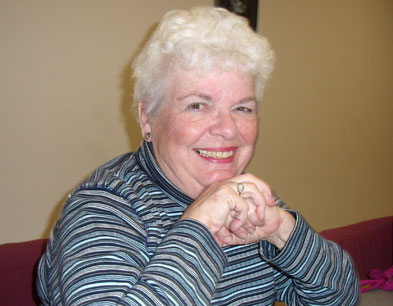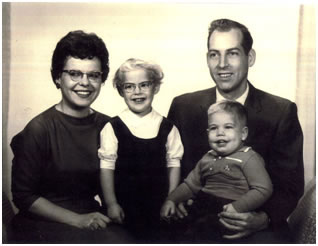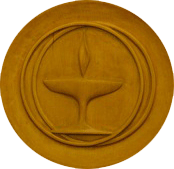
PROFILE: DOROTHY KEELER
-
Born 1934, Toronto, Ont.
-
UCE Activities
-
Worked in the children’s program and chaired the new building committee. Participates in choir, walking group, property management committee.
HOME / OUR HISTORY / TIMELINE / MINISTERS / PROFILES / PHOTO ALBUMS / CONTACT US
Ruth Patrick / Dorothy Keeler / Jack Ratcliff / Ada Nanning / Clarence Collins / Mary Nimmons / Phyllis Ferguson
Marion De Shield / Annabelle & Maurice Bourgoin / Frances Blythe / Bernie Keeler / Morris Simons
Helen Ready / Mary Ayres / Bill Brown
Dorothy Keeler: A UU "lifer" |
||
BY SUSAN RUTTAN |
||
|
To understand Dorothy Keeler, it helps to know that she comes from a long line of strong, smart women. Dorothy’s mother, Avis McCurdy, was a university graduate with wide-ranging interests, including several years on staff at the First Unitarian Congregation of Toronto. Avis also raised four children, two of them adopted, and was active in many progressive social and political causes. She even ran for office as a CCF candidate – as did her husband, Prof. Jarvis McCurdy. Dorothy, therefore, grew up in a family of high intelligence, hard work and social conscience. Born in 1934, she started attending the Unitarian Church in Toronto at kindergarten age, along with her parents. She has never looked back, and today remains a hardworking, faithful Unitarian. Soon after her graduation in 1956 she married Bernie Keeler, a fellow Unitarian whom Dorothy had first met when she was 14. Most of their courtship was a long distance one, as the two pursued their separate university educations. They were married in the First Unitarian Church of Toronto in August 1956, and Dorothy and Bernie wrote their own vows. Not only that, but Dorothy came up the aisle on Bernie’s arm, not her father’s, and the bride was given away by both her parents, not just her father. Heidi was the first Keeler child, followed by two sons and then a second daughter the couple adopted. In 1958 the couple moved to Edmonton so Bernie could do his PhD in educational administration. Dorothy worked at the Alberta School for the Deaf to support the family while Bernie studied. With a second child on the way, the Keelers moved to Toronto and stayed with Dorothy’s parents while Bernie completed the internship year of his PhD. In 1960 the Keelers returned to Edmonton, this time to stay, and in 1961 Bernie became principal of the new Jasper Place Composite High School. Dorothy, meanwhile, completed her teaching degree and began teaching – along with having and raising her children. “I had very few years when I taught full time,” Dorothy recalls. She coped with her work and houseful of young children with the help of live-in housekeepers. “I had 27 housekeepers during that time,” she says. “They were entirely unwed mothers.” The pregnant young women would stay with the Keelers until their babies came – babies were routinely given for adoption in those days – and then move on. The Keelers would already have the next unwed mother in place before the first one left, with two girls overlapping for a month. “I don’t think I ever had a girl who kept a baby until the very last one. She came to me (as a housekeeper) three times and she kept her third one.” “As soon as we knew we were going to stay in Edmonton, one of the very first things we did was come over and join the church.” At that time, in 1961, Edmonton Unitarians were meeting in a former Presbyterian Church on 110th Avenue, and the UCE had already built a church school next to that building. A few years later the Presbyterian Church was knocked down and a new church built, and attached to the church school building. That remained the UCE church until the move to the current church building in 2005. As their family grew – the youngest, adopted daughter Megan, came in 1967 – the Keelers became very involved in the church school. Younger son Scott would go on lead the UCE youth group for years. Dorothy recalls a church school of 160 children when the Keeler children were young. One reason, she points out, is that couples had more children in those days. There was a minister on staff just to handle the huge church school. “Then our numbers began to fall,” Dorothy says. “Part of that was these splinter groups that fell off, part of it was it was the times (the early 1970s) to split marriages up and have partners. We had couples who were sharing partners and so on. It wasn’t our scene but it was for some and that was part of the splintering groups.” Several small groups splintered off from the main church and didn’t survive on their own. However, one splinter group was planned and supported by UCE: the creation of Westwood Congregation near the University of Alberta in 1982. “Westwood was an intentional split, but it did in fact take some of our members away. And some of the potential church school kids too.” Dorothy has seen ministers come and go over her decades at UCE. Rob Brownlee was UCE minister for about 16 years, a time when much of the splintering happened, Dorothy says. Those who left tended to be “people who missed Bob Wrigley’s really high-powered sermons. Rob was good, a good speaker, good at the pastoral work, he’s the one who saved Stan Calder’s life.” But to some, his sermons didn’t equal Wrigley’s. Calder, a longtime UCE member who died in 2008, credited Brownlee for helping him get through a major personal crisis. After Brownlee came Rev. John Marsh, who stayed six years. “He came as a single person and this was a problem because you weren’t supposed to date people from the congregation. So for quite a long time he and Alison (Patrick, daughter of Ruth and Freeman Patrick) did not announce that they were getting married.” Over the years Dorothy has worked in many capacities for UCE, although never as board president – she was too busy with her children and her work. She and Bernie for years took turns working in the church school, and she served on the board on more than one occasion. Dorothy chaired the committee that oversaw the renovation of the Brews building, a warehouse that became the new UCE building in 2005. “There were times when it was extremely frustrating because I felt people were slow about getting together on things,” she recalls. “Andrew Mills was the only thing that saved me from going insane because he was here at 7:30 every morning supervising the actual construction.” Mills was project manager for the Brews project. Dorothy helped create the UCE women’s walkers group that goes walking each Friday morning. Her co-creator was the late Nancy Collinge. “When Nancy died Helen Ready took over for her. So Helen Ready and I now do it.” Dorothy sings in the choir, and says there’s been a choir at UCE on and off since the beginning in 1954. She thinks one of the founders, Dick Morton, had a choir. One of Bob Wrigley’s wives led a choir for a while, then Stella Clarke led a choir for a while. In recent years it’s been Karen Mills and Gordon Ritchie. One of Dorothy’s biggest concerns is the lack of a denominational affairs committee – a committee focused on connections with the church in other cities. She and Bernie go to many regional and national Unitarian conferences because “we’re UU junkies”, she laughs. But UCE in general is a “very insular group”, she says. What that insularity means, Dorothy says, is “that if people leave here, unless they are very dedicated Unitarians, they don’t go to the Unitarian church anywhere else. Because they belong to this church, they don’t belong to the denomination. This is the thing that I think we really need to work on.” “Red Deer has a little tiny Unitarian group, about 10-12 people. They’ve had it that way for 40 years.” A well-publicized Unitarian concert might give them a lift and draw members to their fellowship. “Another little dream: Every new member who hasn’t been before should have his way paid to the (CUC) western regional gathering some day. That would be their gift from the church for going. They go and they see, ‘holy smoke, I’m not part of a little one-horse organization’.”
[Interviewed in 2008]
© 2010 Unitarian Church of Edmonton |
||
 Dorothy with her husband and children.
Dorothy with her husband and children.